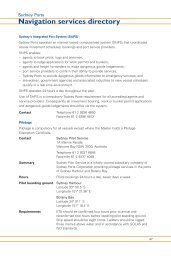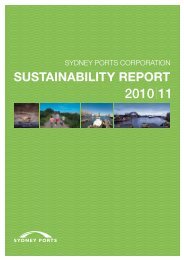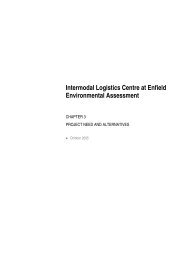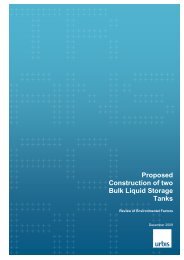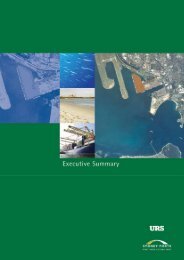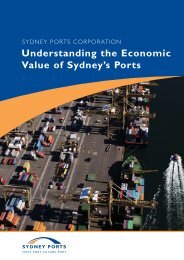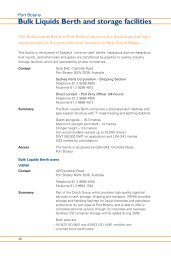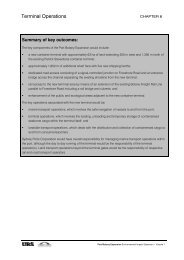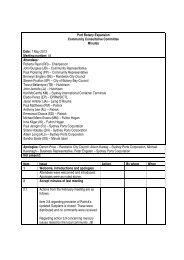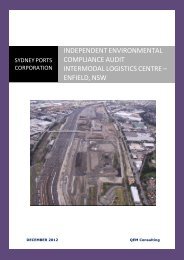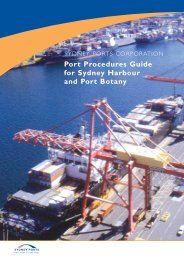SYDNEY PORTS CORPORATION ANNUAL REPORT 12
SYDNEY PORTS CORPORATION ANNUAL REPORT 12
SYDNEY PORTS CORPORATION ANNUAL REPORT 12
Create successful ePaper yourself
Turn your PDF publications into a flip-book with our unique Google optimized e-Paper software.
(l) Recoverable amount of assets<br />
At each reporting date, the Corporation assesses whether<br />
there is any indication that an asset may be impaired.<br />
Where an indicator of impairment exists, the Corporation<br />
makes a formal estimate of recoverable amount.<br />
Where the carrying amount of an asset exceeds its<br />
recoverable amount the asset is considered impaired and<br />
is written down to its recoverable amount. The recoverable<br />
amount is determined for an individual asset unless the<br />
asset does not generate cash inflows that are largely<br />
independent of those from other assets or groups of assets.<br />
If this is the case, recoverable amount is determined for the<br />
cash-generating unit to which the asset belongs, unless<br />
either the asset’s fair value less costs to sell is higher than<br />
its carrying amount, or the asset’s value in use can be<br />
estimated to be close to its fair value less costs to sell and<br />
fair value less costs to sell can be determined. In assessing<br />
value in use, the estimated future cash flows are<br />
discounted to their present value using a pre-tax discount<br />
rate that reflects current market assessments of the time<br />
value of money and the risks specific to the asset.<br />
(m) Channel dredging cost<br />
The Corporation has incurred costs to dredge Botany Bay<br />
thereby creating a channel for ships to enter the wharf area<br />
constructed as part of its Port Botany expansion project.<br />
The Corporation is applying the accounting treatment<br />
agreed with NSW Treasury, relevant Port Corporations and<br />
Roads and Maritime Services (formerly Maritime Authority<br />
of NSW) in 2008. Under the accounting treatment, costs<br />
incurred for capital dredging (harbour deepening) of<br />
channels are recognised as a prepaid licence fee with the<br />
licensor being NSW Roads and Maritime Services (a NSW<br />
Government Authority). The prepayment is amortised over<br />
the period of the licence.<br />
(n) Assets held for sale<br />
Assets (or disposal groups comprising assets and<br />
liabilities) whose carrying amounts are expected to be<br />
recovered primarily through sale rather than through<br />
continuing use are classified as held for sale. Immediately<br />
before classification as held for sale, the assets are<br />
re-measured in accordance with the Corporation’s<br />
accounting policies. Thereafter, assets held for sale are<br />
measured at the lower of carrying amount and fair value<br />
less costs to sell; not depreciated; reclassified from<br />
non-current to current; and separately presented in the<br />
statement of financial position. An impairment loss is<br />
recognised in profit or loss for any initial and subsequent<br />
write down from the carrying amount measured<br />
immediately before reclassification or re-measurement to<br />
fair value less costs to sell.<br />
A gain is recognised for any subsequent increases in fair<br />
value less costs to sell of an asset (or disposal group), but<br />
not in excess of any cumulative impairment loss previously<br />
recognised. A gain or loss not previously recognised by the<br />
date of the sale of the non-current asset (or disposal group)<br />
is recognised at the date of derecognition.<br />
The sale of the asset should be expected to qualify for<br />
recognition as a completed sale within one year from the<br />
date of classification. The Corporation may extend the<br />
period where events and circumstances beyond the control<br />
of the Corporation cause a delay and there is such<br />
evidence that the Corporation remains committed to its<br />
plans to sell the asset.<br />
(o) Trade and other payables<br />
Trade and other payables are carried at amortised cost<br />
and due to their short-term nature they are not discounted.<br />
Trade and other payables represent liabilities for goods and<br />
services provided to the Corporation prior to the end of the<br />
financial year that are unpaid and arise when the Corporation<br />
becomes obliged to make future payments in respect of the<br />
purchase of these goods and services. The amounts are<br />
unsecured and are usually paid within 28 days of recognition.<br />
(p) Interest-bearing loans<br />
All loans and borrowings are initially recognised at cost,<br />
being the fair value of the consideration received net of<br />
issue costs associated with the borrowing. After initial<br />
recognition, interest-bearing loans and borrowings are<br />
subsequently measured at amortised cost using the<br />
effective interest method. Amortised cost is calculated by<br />
taking into account any issue costs, and any discount or<br />
premium on settlement. Gains and losses are recognised in<br />
the statement of comprehensive income when the liabilities<br />
are derecognised.<br />
(q) Borrowing costs<br />
Borrowing costs are expensed as incurred within finance<br />
costs in the statement of comprehensive income unless<br />
they relate to qualifying assets, in which case they are<br />
capitalised as part of the cost of those assets. Qualifying<br />
assets are assets that take a substantial period of time to<br />
be ready for their intended use.<br />
Capitalisation of borrowing costs is undertaken where a<br />
direct relationship can be established between the<br />
borrowings and the relevant projects giving rise to the<br />
qualifying assets. Where funds are borrowed specifically<br />
for the acquisition, construction or production of a<br />
qualifying asset, the amount of borrowing costs capitalised<br />
is net of any interest earned on those borrowings.<br />
(r) Provisions<br />
Provisions are recognised when the Corporation has a<br />
present obligation (legal or constructive) as a result of a<br />
past event, it is probable that an outflow of resources<br />
embodying economic benefits will be required to settle the<br />
obligation and a reliable estimate can be made of the<br />
amount of the obligation.<br />
Where the Corporation expects some or all of a provision<br />
to be reimbursed, for example under an insurance contract,<br />
the reimbursement is recognised as a separate asset but<br />
only when the reimbursement is virtually certain and can<br />
be measured reliably. The expense relating to any provision<br />
is recognised in the statement of comprehensive income<br />
net of any reimbursement. If the effect of the time value of<br />
money is material, provisions are determined by discounting<br />
the expected future cash flows at a pre-tax rate that<br />
reflects current market assessments of the time value of<br />
money and, where appropriate, the risks specific to the<br />
liability. The increase in the provision due to the passage<br />
of time is recognised as interest expense.<br />
Sydney PortS CorPoration finanCial rePort 2011/<strong>12</strong> 53



